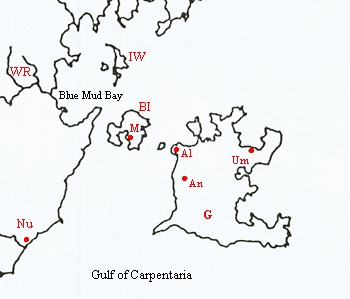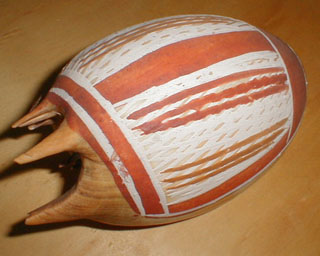|
Groote
Eylandt
Groote Eylandt
lies on the western side of the Gulf of Carpentaria, just
east of the Walker River and southeast of Blue Mud Bay. The
Wanindilyaugwa of Groote Eylandt (whom speak Enindilyaugwa
- often written as Anindilyakwa) have close kinship and ceremonial
ties to Nunggubuyu people immediately adjacent on the mainland
(around Numbulwar).

| G -
Groote Eylandt |
An -Angurugu* |
| BI -
Bickerton Island |
Um -
Umbakumba* |
| IW -
Isle Woodah |
M -
Milyakburra* |
| WR -
Walker River |
Al -
Alyangula* |
| |
Nu -
Numbulwar* |
|
* Aboriginal community
Alice Moyle provides
some detail of the range of characteristics typical of songs
and music of eastern Arnhem Land and neighbouring Groote Eylandt.
Of particular interest here are the following characteristics
indicative of Groote Eylandt clan song (emeba) which
distinguish such clan songs from those in northeastern Arnhem
Land (manikay);
- "the shaky
voice, a deliberate manner of vocal ornamentation used by
some emeba singers;
- the 'break'
or brief cessation of the vocal part of a Groote Eylandt
clan song which is signalled by certain words the singer
chooses to sing (the song subject at this point may fall,
swoop down, or change abruptly in some way - it was said
that the 'break' gives the singer time to decide which words
to sing next);
- a short, patterned
interlay between sticks and didjeridu during the 'break';
and
- the general
clatter of stick-beating percussion arising from several
different sources at the same time." Such as clapsticks,
sticks against another stick on the ground (often a spearthrower)
and/or a stick against the didjeridu.
Groote Eylandt songs
tend also to be of a much longer duration, often more than two
minutes, whereas most eastern and northeastern songs are a minute
or less in length (Moyle). To Groote Eylandters the didjeridu
is known as yiraga.
Discography
& Notes
| Title
of Recording |
Track/Band |
Recording
Location/Date |
Notes |
| Aboriginal
Music from Groote Eylandt and Bickerton Island,
Australia, Turner |
Tracks
1-36 |
1969? |
Fine
examples of a range of song styles and rhythms
of Groote Eylandt |
| Songs
from the Northern Territory, Vol. 4. Moyle |
track
7 |
Angurugu,
Groote Eylandt, 1962 |
The
'break' in these songs occurs following the songman
singing the lyrics referring to a sea eagle swooping
for its' catch. The didjeriduist also changes
the rhythm and uses the overtone at this point. |
| |
tracks
8a,b |
Bagot,
Darwin, 1962 |
This
Groote singer was resident at Bagot at the time. |
| |
track
9a, |
Umbakumba,
Groote Eylandt, 1962 |
Excellent
example of shaky voice singing. |
| |
track
9b |
Umbakumba,
Groote Eylandt, 1962 |
This
track is unusual in that the didjeriduist continues
after the vocals have finished. Moyle says that
on her original recording the player remarked
laughingly that he "didn't know how to make
it stop". |
| |
track
10a |
Angurugu,
1963 |
This
song of seaweed describes a piece of black tree
coral being dragged back and forth with the tide
- the 'break' occurs when it gets buried in the
sand. Superb vocals. |
| |
track
10b |
Angurugu,
1963 |
The
didjeridu is being played with the distal end
in a wooden box. This is not unusual - often an
old metal drum or an upright piece of tin may
serve the same purpose. In the past a bailer
shell was used. |
| |
track
10d |
Angurugu,
1963 |
Here
the 'break' occurs where the lyrics describe 2
planes that fly off in different directions. |
| |
track
10e |
Angurugu,
1963 |
Didjeridu
and sticks only |
| |
track
10c |
Angurugu,
1963 |
Didjeridu
and sticks only |
| |
tracks
11a,b,c,12a,b |
Angurugu,
1963 |
Fine
examples of Groote style |
| Aboriginal
Sound Instruments, Moyle |
Side
2, Band 1 (c) |
Groote
Eylandt, 1964 |
Didj
only and "mouth sounds" |
| |
Side
2, Band 2 (e) |
Groote
Eylandt, 1964 |
Shaky
voice style. The didjeriduist changes instruments
about a third of the way into the song (the new
one is of a different pitch). He told Moyle he
did this because the mouthpiece didn't fit his
mouth properly (Moyle, 1978) |
|
Please
Note: The names of performers are
not included wherever it is known or suspected they may be recently
deceased.

|

